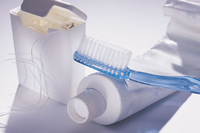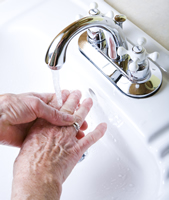Everyday Personal Care

 After a stroke, your loved one may need help with personal care activities. These include bathing, dressing, toileting and oral or mouth care.
After a stroke, your loved one may need help with personal care activities. These include bathing, dressing, toileting and oral or mouth care.
What Do You Need to Know?
It may be hard for your loved one to accept your help. Feeling embarrassed or ashamed are normal emotions. Listen to your loved one talk about how they feel. Be supportive and understanding. Allow your loved one to do as much as possible. Be close by to help if needed.
back to top
Helpful Tips
Bathing
- Plan bathing at the time of day when your loved one has the most energy.
- Gather all supplies ahead of time. Never leave an unsteady loved one alone in the bath or shower.
- Check the temperature of the water before you start. Make sure the water is not “too hot” or “too cold.”
- Let your loved one do as much as possible. Allow him or her to wash the parts within reach.
- Use assistive devices to make bathing easier and safer. These can include a shower bench, non-skid bath mats and grab bars.
What if your loved one is bedridden?
If your loved one is bedridden (unable to get out of bed), you can do a bed bath. To make it easier, perform the bed bath in steps.
- First, cover the body with towels.
- Wash in sections, removing only 1 towel at a time.
- Cover the area again after drying. This will provide privacy and keep your loved one warm.
Dressing
- Assistive devices, like zipper pulls, can help your loved one dress themselves. Velcro ®** closures can be used to replace buttons, zippers and shoe laces.
- Loose fitting clothes are best. It’s harder to put on tight fitting clothes. Pants or skirts with elastic waistbands are easy to pull on and off.
- Clothes should fasten in the front. Avoid clothing that needs to be pulled over the head.
- Have your loved one sit down to dress. Put the affected arm/leg into clothes first. When undressing, take the affected arm/leg out of the clothes last.
- Shoes should have a non-skid tread and not slip off easily. Use shoes with Velcro®** fasteners.
Grooming
- Shaving can be made safer by using an electric razor. This will reduce the risk of cuts and nicks.
- Long handle hairbrushes or combs will be easier for your loved one to use.
Toileting
- Make sure the walkway to the bathroom is well-lit.
- If needed, place a bedside commode or a urinal near the bed at night. Put the commode and urinal in the closet during the day to avoid embarrassing your loved one.
- Only use adult diapers as a last resort.
Oral or Mouth Care
- Help your loved one brush his or her teeth twice a day.
- Remember to brush the tongue. The tongue is covered with bacteria that can lead to dental problems.
- Take note of the color of gums and condition of teeth. Notify the dentist if you have concerns.
Skin Care 
- Avoid using soaps and bubble bath with fragrances. Chemicals in these items often irritate the skin. Itching and rashes may occur. Make sure to completely rinse the skin with clean water after washing.
- Avoid using laundry detergents or fabric softeners with fragrances. They also can irritate the skin. Use dye-free products instead.
- Use a lotion after bathing to keep the skin moist. Avoid using lotions with perfumes or alcohol. Use a lotion high in petroleum, such as Aquaphor ™** to prevent dry skin.
- Check the skin regularly for any rashes or sores. A good time to do this is during bath time. Talk to your healthcare team about any concerns.
Is Your Loved One at Risk for Pressure Sores?
Being confined to a bed or a wheelchair raises the risk of pressure sores. Pressure sores happen when “pressure” to parts of the body decreases the blood flow. This can occur from laying or sitting too long. The most common areas for pressure sores are boney areas. These include heels, elbows, hips and the tailbone.
To prevent pressure sores:
- Change position at least every two hours. Use a lifting sheet to move your loved one. This will keep the skin from being dragged across the bed sheets.
- Change bed sheets daily or more often to keep your loved one clean and dry. Skin that sits in urine or sweat is more likely to develop a sore.
- Keep bed sheets pulled flat. Wrinkles in sheets can rub skin and cause pressure sores.
- Place pillows or pads between the knees and under elbows and ankles.
- If possible, get your loved one up and moving. This will increase blood flow and lower the chance of pressure sores.
Remember
- Be supportive and listen. Your loved one may be ashamed to accept help.
- Let your loved one do as much as possible.
- Use assistive devices to make personal care easier and safer.
More Resources 
Additional credible resources on this topic can be found here. Website pages may change or update, therefore if a link does not work, you may also try to type the information into your internet search bar. This Resource List will be updated frequently.
References: Houts, P.S. (Ed.). (2004). ElderCare At Home. (2nd Ed.). New York, NY: The AGS Foundation for Health in Aging; Hope for Stroke: The Recovery Guide, National Stroke Association, http://www.stroke.org/site/PageServer?pagename=HOPE*; Caring Connections. (n.d.). Retrieved September 26, 2008, from Web site: http://www.caringinfo.org/CaringForSomeone.htm*; Caregiver Support (n.d.). Retrieved September 26, 2008, from Sage Products Inc. Web site; http://www.shopsageproducts.com/caregiver-support/*; Caregiver Guide: Tips for Caregivers of People with Alzheimer’s disease. (2007). Retrieved September 26, 2008 from National Institutes on Aging, http://www.nia.nih.gov*
|
*Link Disclaimer: Links to information and Web sites outside of the Department of Veterans Affairs do not indicate an endorsement of products or services offered by the sites. In addition, these sites may have privacy and security policies that are inconsistent with those of VA. |
These materials were created for the project:
Web-Based Informational Materials for Caregivers of Veterans Post-Stroke
Project Number SDP 06-327 funded by VA HSR&D Quality Enhancement Research Initiative (QUERI)



















